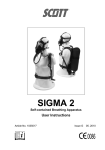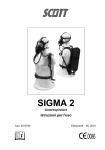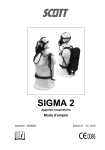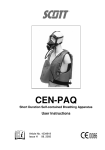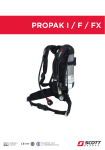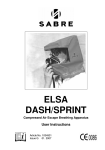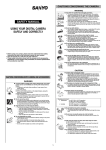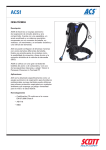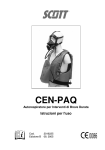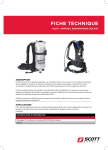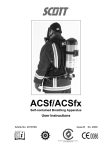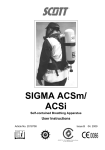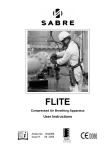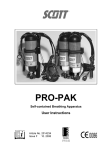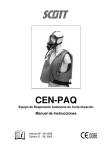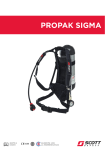Download SIGMA 2
Transcript
SIGMA 2 Self-contained Breathing Apparatus User Instructions Article No. 1035017 Issue F 12. 2004 Self-contained Breathing Apparatus Contents WARNINGS................................................................................................................................................................................ii 1. INTRODUCTION........................................................................................................................................................1 1.1 IMPORTANT ..............................................................................................................................................1 1.2 BREATHABLE AIR.....................................................................................................................................1 1.3 APPARATUS DURATION ..........................................................................................................................1 1.4 PERSONNEL TRAINING ...........................................................................................................................1 1.5 SERVICING................................................................................................................................................2 1.6 SPARE PARTS AND ACCESSORIES .......................................................................................................2 1.7 NOTIFIED BODIES ....................................................................................................................................2 2. TECHNICAL DESCRIPTION .....................................................................................................................................2 2.1 GENERAL ..................................................................................................................................................2 2.2 APPARATUS DESCRIPTION ....................................................................................................................2 2.3 PNEUMATIC SYSTEM...............................................................................................................................4 2.4 REDUCER..................................................................................................................................................4 2.5 DEMAND VALVE .......................................................................................................................................4 2.6 FACEMASKS .............................................................................................................................................5 3. PRE-USE AND MONTHLY CHECKS........................................................................................................................6 3.1 GENERAL ..................................................................................................................................................6 3.2 PNEUMATICS............................................................................................................................................6 3.3 DEMAND VALVE .......................................................................................................................................6 3.4 CHECK FACEMASK ..................................................................................................................................6 3.5 POSITIVE PRESSURE, BYPASS AND LEAK TEST .................................................................................7 3.6 WHISTLE TEST .........................................................................................................................................7 3.7 REPLACING CYLINDERS .........................................................................................................................7 3.7.1 Fitting a replacement Cylinder of the same size........................................................................8 3.7.2 Fitting a replacement Cylinder of a different size. .....................................................................8 4. DONNING PROCEDURE ..........................................................................................................................................8 4.1 HARNESS ..................................................................................................................................................8 4.2 DON FACEMASK.......................................................................................................................................8 4.2.1 Head Harness............................................................................................................................8 4.2.2 Headnet .....................................................................................................................................9 4.3 OPEN CYLINDER VALVE..........................................................................................................................9 4.4 FACEMASK SEAL CHECK ...................................................................................................................... 10 4.5 BYPASS CHECK...................................................................................................................................... 10 4.6 LEAK TEST .............................................................................................................................................. 10 4.7 WHISTLE TEST ....................................................................................................................................... 10 4.8 CYLINDER PRESSURE........................................................................................................................... 11 5. DOFFING INSTRUCTIONS ..................................................................................................................................... 11 5.1 REMOVE FACEMASK ............................................................................................................................. 11 5.2 TURN OFF CYLINDER ............................................................................................................................ 12 5.3 REMOVE APPARATUS ........................................................................................................................... 12 5.4 CLEAN AND CHECK APPARATUS......................................................................................................... 12 6. AFTER USE............................................................................................................................................................. 12 6.1 CLEAN FACEMASK................................................................................................................................. 12 6.2 CLEAN APPARATUS............................................................................................................................... 13 6.3 DEMAND VALVE ..................................................................................................................................... 13 6.4 CHECK APPARATUS .............................................................................................................................. 13 6.5 FIT FULLY CHARGED CYLINDER.......................................................................................................... 13 6.6 LEAK TEST .............................................................................................................................................. 13 6.7 RECORD TEST DETAILS........................................................................................................................ 14 6.8 STORAGE................................................................................................................................................ 14 7. SCHEDULED MAINTENANCE................................................................................................................................ 14 7.1 MONTHLY................................................................................................................................................ 14 7.2 ANNUALLY .............................................................................................................................................. 14 DECLARATION OF CONFORMITY - MARINE EQUIPMENT DIRECTIVE ............................................................................. 15 Registered Office: Scott Health and Safety Limited, Pimbo Road, West Pimbo, Skelmersdale, Lancashire, WN8 9RA, United Kingdom. i WARNINGS Please Read Carefully and Fully Understand This manual is for use by personnel trained in the use and care of compressed air breathing apparatus, and MUST NOT be used as a self-teaching guide by untrained users. Failure to understand or adhere to the SIGMA 2 User Instructions may result in injury or death. Scott Health and Safety Limited have taken great care to ensure that the information in this manual is accurate, complete and clear. However, Training & Technical Support Services will be pleased to clarify any points in the manual and answer questions on SCOTT breathing apparatus. The following warnings are in accordance with certifying authority requirements and apply to the use of breathing apparatus in general: Breathing apparatus users must be fully trained in the use and care of selfcontained, compressed air breathing apparatus. Ensure that the selection of the apparatus type is sufficient for the tasks being undertaken and the hazards likely to be encountered. Please refer to National Regulations for guidance. In order to ensure the optimum performance and user safety, the apparatus must be tested and serviced in accordance with Section 7 and the notes in Section 1 under Personnel Training and Servicing. The quality of air used to supply and charge breathing apparatus must meet the requirements of EN 132 : 1990. See Section 1 for details. The wearing of beards, side-burns or spectacles may adversely affect the sealing of a facemask to the wearer's face. The apparatus is not designed for use underwater. The harness must not be used as a vehicle seat restraint. DISCLAIMER Failure to follow these instructions or misuse of the apparatus may result in: death, injury or material damage; and invalidate any warranty or insurance claims. COPYRIGHT This manual must not be copied in part or in whole, or used for purposes other than it’s intended purpose without the written permission of Scott Health and Safety Limited. ii SIGMA 2 The mineral oil content shall be such that the air is without the odour of oil. The odour threshold is in the region of 0.3 mg/m3. 1. INTRODUCTION 1.1 IMPORTANT The water content shall not exceed 50 mg/m3 for 207 bar apparatus and 30 mg/m3 for 300 bar apparatus. SIGMA 2 must be serviced in accordance with the Servicing Schedule on at least an annual basis. Please refer to notes under Servicing. 1.3 These instructions for the use, care and maintenance of the apparatus must be followed to ensure the correct and safe operation of SIGMA 2. For any enquiries regarding the use of SCOTT breathing apparatus, please contact Training & Technical Support Services at Scott Health and Safety Limited. 1.2 1. Workload: high work rates increase consumption rates. 2. Weight of apparatus and use of heavy or restrictive clothing. 3. Work environments with extremes of heat or cold. 4. Physical fitness of the wearer. 5. Other factors include emotional stress and fatigue. It is important that all wearers are aware of these factors and take account of them when assessing cylinder duration. BREATHABLE AIR Air used to supply or charge breathing apparatus may be natural or synthetic. The composition of breathable air is given in Table 1. COMPONENT MASS % (Dry Air) VOLUME% (Dry Air) OXYGEN 23.14 20.948 NITROGEN 75.52 78.08 ARGON 1.29 0.93 CARBON DIOXIDE 0.05 0.031 4 HYDROGEN 0.000 003 0.000 05 NEON 0.001 270 0.001 818 HELIUM 0.000 037 0.000 524 KRYPTON 0.000 330 0.000 114 XENON 0.000 039 0.000 009 APPARATUS DURATION All durations quoted are nominal, based on an Average Wearer Consumption Rate of 40 litres/minute and FULLY CHARGED cylinders. Actual Wearer Consumption rates vary due to many factors, such as: 1.4 PERSONNEL TRAINING Personnel who use self-contained, compressed air breathing apparatus must be fully trained in accordance with these instructions and national regulations. These instructions cannot replace an accredited training course run by fully qualified instructors in the proper and safe use of SCOTT breathing apparatus. Please contact Training & Technical Support Services or your distributor for training course details. Table 1: Breathable Air There is an increased fire risk when the oxygen content is above the value shown. Training & Technical Support Services: Scott Health and Safety Limited Pimbo Road, West Pimbo, Skelmersdale, Lancashire, WN8 9RA, United Kingdom. The purity/quality of air used to supply and charge breathing apparatus should be tested periodically in accordance with national regulations. If not specified otherwise, contaminants shall not exceed the permissible exposure level. Tel: +44 (0) 1695 711711 Fax: +44 (0) 1695 711775 National regulations must be observed. 1 SIGMA 2 1.5 2. TECHNICAL DESCRIPTION SERVICING SIGMA 2 must be serviced at scheduled intervals by personnel who have completed a formal training course and hold a current certificate for servicing and repairing SCOTT breathing apparatus. Details of the servicing schedule are contained in the SCOTT SIGMA 2 Service Manual, copies of which can only be obtained by registered holders of a current certificate. 2.1 Your distributor or Training & Technical Support Services can provide training course details and quotes for service contracts. Please see above for contact details. 1.6 SIGMA 2 is approved for use at sea by: Lloyds Inspectorate, in accordance with SOLAS regulation 17 and the 1980 Merchant Shipping Act. Marine Equipment Directive, certified on the basis of a BSI examination to the requirements of Council Directive 96/98/EC, as amended by 98/85/EC. SPARE PARTS AND ACCESSORIES Our Customer Services Department provide an efficient, friendly, customer contact point for ordering new apparatus, spare parts and accessories. The team can also provide general information on SCOTT products. Please call Scott Health and Safety Limited for further apparatus approval details. 2.2 Customer Services: APPARATUS DESCRIPTION SIGMA 2 has a lightweight backplate and harness. The two stage pneumatic system consists of a first stage reducing valve; and a Demand Valve (DV) that is attached by a bayonet fitting, to the positive pressure full facemask. Scott Health and Safety Limited Pimbo Road, West Pimbo, Skelmersdale, Lancashire, WN8 9RA, United Kingdom. Tel: +44 (0) 1695 711711 Fax: +44 (0) 1695 711775 1.7 GENERAL SIGMA 2 is a self-contained, open circuit, compressed air, positive pressure, breathing apparatus, approved to EN 137 (self-contained open circuit breathing apparatus). It is ' CE'marked in accordance with Council Directive 89/686/EEC. The backplate is injection moulded polyamide/glass/carbon composite, with a fully adjustable flame retardant polyester webbing harness. The Kevlar cylinder band is fully adjustable and can accommodate one cylinder from the range listed in Table 2. A glass-filled polyamide cam-lock buckle facilitates quick and easy cylinder replacement. A lumbar pad, fabricated from flame retardant polyester and packed with flame retardant closed cell foam, cushions the weight of the apparatus. It is attached to the lower backplate by means of press-studs. Pneumatic hoses run in channels moulded into the inner backplate. Hose retaining clips are moulded on the edge of the channels. A cylinder valve retainer on the lower backplate provides a secure mounting for the cylinder valve. NOTIFIED BODIES Inspec International Ltd (No. 0194) Upper Wingbury Courtyard, Wingrave, Aylesbury, Buckinghamshire, HP22 4LW, United Kingdom. British Standards Institute (No. 0086) 389 Chiswick High Road, London, W4 4AL, United Kingdom. 2 SIGMA 2 Cylinder Types Water Volume (litres) Charging Pressure Free Air Volume (litres) Nominal Duration (minutes) Warning Period (minutes) Total Duration (minutes) Cylinder Charged Weight (Kg) CYL-1200 6.0 207 1200 22 8 30 8.8 CYL-HWG-1200 6.0 207 1200 22 8 30 7.2 CYL-FWC-1300 4.7 300 1300 25 7 32 5.0 CYL-1640 6.0 300 1640 33 8 41 12.5 10.0 CYL-HWG-1640 6.0 300 1640 33 8 41 CYL-FWC-1640 6.0 300 1640 33 8 41 6.3 CYL-1800 9.0 207 1800 33 12 45 13.0 CYL-HWG-1800 9.0 207 1800 33 12 45 11.2 CYL-FWC-1800 9.0 207 1800 33 12 45 6.75 CYL-FWC-1860 6.8 300 1860 37 9 46 6.75 CYL-2240 11.0 207 2240 41 15 56 14.4 CYL-FWC-2460 9.0 300 2460 50 12 62 8.8 Table 2: Cylinders approved for use with SIGMA 2 Cylinder Material is identified by codes within the Cylinder Type. Table 3 identifies the meaning of the cylinder material code and the specification to which the cylinder is manufactured: Code Material Specification No Code Steel (e.g.: CYL-1200) BS5045 Pt.1 HWG Hoop Wrapped Glass Fibre (e.g.: CYL-HWG-1200) HSE-AL-HW1 FWC Fully Wrapped Carbon (e.g.: CYL-FWC-1300) HSE-AL-FW2 Table 3: Cylinder Codes and Specifications Durations are nominal and based on an Average Wearer Consumption Rate of 40 L/min and are for fully charged cylinders. Total Duration = Nominal Duration = Warning Period = Cylinder Free Air Capacity Average Wearer Consumption Rate Total Duration minus the Warning Period. Cylinder Water Capacity x Whistle Operating Pressure Average Wearer Consumption Rate 3 SIGMA 2 2.3 PNEUMATIC SYSTEM 2.5 The first stage pressure reducer has an integral cylinder connector handwheel. There is a sintered bronze particle filter in the reducer inlet. DEMAND VALVE SIGMA 2 is available with two types of Demand Valve (DV): • Instant air positive pressure DV (blue) • First breath-activated DV (black). A high pressure PTCFE lined hose supplies air to a shoulder mounted pressure gauge and warning whistle. Both types of DV have a supplementary flow bypass and operate in conjunction with the spring-loaded facemask exhalation valve to maintain a positive pressure within the facemask. The pressure gauge has a stainless steel case and a polycarbonate, impact resistant, splinter-proof lens. A blow-out vent prevents over pressurisation of the case. A rubber shroud provides mechanical protection. The DV senses the changes in facemask air pressure that occur when the wearer breathes; and uses this to regulate the supply of air to the facemask. The DV is attached to the facemask by a quick-fit bayonet connection with a spring loaded locking catch. The warning whistle operates at 55 bar. Table 2 details the Warning Period for each apparatus and cylinder combination. If the hose, whistle or gauge become damaged, a restrictor in the reducer body limits air loss to 25 litres/minute. 2.4 REDUCER Instant Air Demand Valve The instant air DV supplies air to the facemask when the cylinder valve is opened. The pressure reducer is a simple spring and piston device that reduces the pressure of air from the cylinder to a medium pressure of between 5 and 9 bar. The operation is automatic and selfregulating such that the reducer requires no adjustment. In the unlikely event of a malfunction in the reducer, resulting in an uncontrolled rise in the output pressure, a pressure relief valve protects the medium pressure system. A reinforced hose supplies pressure air to the DV. First Breath Demand Valve medium 4 SIGMA 2 The first breath version can be shut by pressing a reset button on the DV and opens when the wearer takes the first breath. This permits the DV to be removed from the facepiece while the cylinder valve is open, without loss of cylinder air. PanaSeal is suitable for medium and smaller face sizes. PanaVisor is suitable for medium to larger face sizes. Vision 3 is available in three sizes: small, medium and medium/large. The bypass provides a constant flow of air in the unlikely event that the regulator malfunctions in a ‘no flow’ mode. The bypass is opened by turning the knob through 90°. As use of the bypass consumes cylinder air rapidly, it must only be used to escape from the hazardous area. 2.6 FACEMASKS SIGMA 2 is approved for use with: Vision 3, PanaSeal and PanaVisor full facemasks, all of which conform to EN 136. All are available with 5-point, fully adjustable web or net head harnesses and neckstraps. An inner mask minimises CO2 dead space and visor misting. A speech diaphragm is fitted. PanaSeal/PanaVisor Facemask with Headnet Vision 3 is moulded in grey silicone, while PanaSeal and PanaVisor are nondermatitic black neoprene, or blue silicone. Vision 3 Facemask with Headharness 5 SIGMA 2 3. PRE-USE AND MONTHLY CHECKS 3.1 3.3 DEMAND VALVE 1. Check that the DV O-ring is clean and undamaged. GENERAL 2. Fit the DV to the facemask and check that the locking catch clicks into place. Gently twist the DV to ensure that it is securely fitted. 1. Check that all parts are clean and undamaged. 2. Ensure that the shoulder harness is fully slackened and that a fully charged cylinder is securely attached to the backplate. Replace discharged cylinders. 3. Check that the harness slides freely through buckles. 4. Check that the facemask visor is clear and free from marks and damage that might impair vision. Fully slacken headharness straps. 5. Apparatus that fails any of these checks must be serviced in accordance with the SIGMA 2 Service Manual. 3.2 3. Check that the bypass valve is closed (flat area on knob is toward the facepiece). PNEUMATICS 4. On first breath DVs only, press the black reset button. 3.4 1. Check cylinder connector O-ring is clean and undamaged. 1. CHECK FACEMASK Don the facemask (see Section 4.2). 2. Open the cylinder valve and check that the cylinder is full. 2. Screw handwheel connector firmly into the cylinder valve outlet. 3. Check that the facemask pressurises. If necessary adjust the mask to obtain a leak tight fit. DO NOT overtighten the harness as this distorts the mask. 3. Check that pressure gauge, whistle and hoses are in good condition and are not kinked or stretched. 6 SIGMA 2 3.5 POSITIVE PRESSURE, BYPASS AND LEAK TEST 3.6 WHISTLE TEST 1. With the cylinder valve still closed, monitor the pressure gauge and breathe down air in the system. Check that the whistle sounds clearly at between 50 and 60 bar. 1. Insert fingers in the facemask seal and check there is a steady flow of air out of the mask. 2. Remove fingers and allow mask to re-seal. 2. Release headharness and remove the facemask. 3. Apparatus that passes all of these checks is now ready for use. 3.7 REPLACING CYLINDERS 3. Open the bypass and check there is a steady flow of air into the facemask. 4. Close the bypass. 5. Close the cylinder valve, hold your breath, and monitor the pressure gauge for 10 seconds. Check that the reading does not drop during this period. 1. Check that the cylinder valve is closed and slowly undo the cylinder connector handwheel. Remove the reducer from the cylinder. 7 SIGMA 2 2. Grasp the sides of the cam-lock buckle with the index finger and thumb of the right hand, use the left index finger to slide back the ribbed catch and lift the buckle. 4. DONNING PROCEDURE 4.1 HARNESS 3. Open the buckle and lift the empty cylinder from the backplate. 3.7.1 Fitting a replacement Cylinder of the same size. 1. Fit the cylinder valve through the cylinder valve retainer, connect the buckle hinge and close the cam-lock. 3.7.2 Fitting a replacement Cylinder of a different size. 1. Don apparatus. Adjust shoulder straps for a comfortable fit, then fasten waistbelt and adjust for a snug fit. 4.2 DON FACEMASK 1. Check that the bypass is shut (and on first breath DVs, press the DV reset button). 1. Adjust the length of the cylinder band to permit the buckle hinge to be connected. 4.2.1 2. Adjust the cylinder band length until the cylinder band grips the cylinder firmly, then close the cam-lock. Head Harness 3. Tidy the free end of the cylinder band into the loops. 1. Let facemask hang loosely from face and breathe normally. 8 SIGMA 2 3. Tighten the side straps for a firm, comfortable fit. DO NOT over-tighten as this distorts the face seal. 2. Fit the chin into the chin-cup, pull the harness over the top of the head and tighten the straps in sequence: bottom, middle, top. DO NOT over-tighten. 4.2.2 4.3 OPEN CYLINDER VALVE Headnet 1. 1. With the headnet straps fully extended, insert the chin into the chin-cup and use the loop at the back of the headnet to pull the headnet over the head. 2. Tighten the top strap to bring the visor and ori-nasal mask to the correct level. 9 Slowly open cylinder valve fully: • On Instant Air DVs, check that the DV free-flows into facemask until the headharness straps are tightened. • On First Breath DVs, inhale sharply to start the air supply to the facemask. SIGMA 2 4.4 FACEMASK SEAL CHECK 4.6 1. Take a breath and hold it. Release handwheel locking-mechanism and close the cylinder valve. 1. Insert fingers in facemask seal and check for a steady flow of air from the mask. Remove fingers and allow mask to re-seal. 4.5 LEAK TEST 2. Listen for leaks and monitor gauge for 10 seconds. The reading on the gauge should not fall during this period. BYPASS CHECK 4.7 WHISTLE TEST 1. Open the bypass and check there is a steady flow of air into the facemask. 2. Close the bypass. 1. Slowly breathe down the air from the system and check that the whistle sounds clearly at between 50 and 60 bar. 2. If the whistle or facemask fail the test, return the apparatus for servicing, with an explanatory note attached, in accordance with the SIGMA 2 Servicing Instructions. 10 SIGMA 2 4.8 5. DOFFING INSTRUCTIONS CYLINDER PRESSURE 1. Open cylinder valve and check pressure gauge to ensure that cylinder has a minimum of 80% of the fully charged capacity: For 207 bar cylinders - 170 bar. For 300 bar cylinders - 240 bar. 5.1 REMOVE FACEMASK 2. When fully satisfied with apparatus, proceed to undertake tasks as required. 1. On apparatus with a First Breath DV, take a breath and press the reset button to close the air supply. 2. Pull tabs on buckles forward to release the headharness or headnet. Remove facemask. Note: Instant Air DVs will free flow through mask until the cylinder valve is closed. 11 SIGMA 2 5.2 6. AFTER USE TURN OFF CYLINDER CAUTIONS: • • • 6.1 1. Disengage the cylinder valve handwheel locking mechanism and turn handwheel fully clockwise to shut the valve. 5.3 DO NOT immerse DV or warning whistle in water. A yellow cap is provided to protect the DV outlet. ALWAYS use the recommended cleaning methods. The apparatus MUST be thoroughly dried prior to storage. Pay particular attention to the valve flaps. CLEAN FACEMASK REMOVE APPARATUS 1. Withdraw red locking catch, turn 90° clockwise and remove the DV from the facemask. 2. Wash and disinfect the mask thoroughly in a solution of TriGeneTM and warm water. See following Note. 1. Release the waistbelt, slacken the shoulder straps and remove the apparatus. 3. Rinse the mask thoroughly in clean running water. Pay particular attention to flushing out the exhale valve. 2. Open cylinder band, undo cylinder valve connector and remove cylinder. 3. Mark cylinder as ‘empty’ and return for charging. 4. Hang mask by its neckstrap and allow it to dry thoroughly away from direct heat or sunlight. 5.4 5. When dry, wipe facemask seals with TriGeneTM disinfectant wipes. CLEAN AND CHECK APPARATUS 6. Polish the visor inside and out with a clean, lint-free cloth and slacken the head harness, ready for use. 1. The apparatus must be cleaned and tested in accordance with the instructions given in Section 6 - After Use, prior to being returned to service. 12 SIGMA 2 Note: TriGeneTM Cleansing and Disinfecting Solution is available from Scott Health and Safety Limited in 1 litre and 5 litre containers under Article Numbers 2008247 and 2008248 respectively. Pump dispensers are available for the above under Article Numbers 1017672 (1 litre) and 1017670 (5 litres). TriGeneTM Disinfecting Wipes are available from Scott Health and Safety Limited in packs of 20 sachets under Article Number 2004225. 6.2 5. Operate the red locking catch a number of times. Ensure that it moves freely and does not stick. CLEAN APPARATUS CAUTION: DO NOT use abrasive or solvent cleaners. 6.4 1. Fully slacken the shoulder straps and waistbelt. Clean off any dirt with a stiff brush or sponge with warm water and soap, followed by a thorough rinse. 2. Check hoses for signs of abrasion or damage. 2. Ensure that the pressure gauge face is clean. 6.3 CHECK APPARATUS 1. Check apparatus thoroughly for signs of wear or damage. 3. Check harness straps and stitching for signs of weakness. DEMAND VALVE 4. Replace worn or damaged components in accordance with the SIGMA 2 Service Manual. 5. If a fault is found, attach an explanatory note to the apparatus and return it for servicing. 6.5 FIT FULLY CHARGED CYLINDER 1. Fit a fully charged cylinder in accordance with the instructions contained within Section 3 - Pre-Use and Monthly Checks. 6.6 1. Fit the protective yellow cap over the DV outlet and use a small stiff brush with a mild soap and water solution to clean around the catch. LEAK TEST CAUTION: On Instant Positive Pressure DVs (blue), DO NOT fit the yellow cap prior to opening the cylinder valve as this will damage the DV. 2. If the catch does not move freely, return the apparatus for servicing. 3. Check that the orange O-ring on the DV outlet is clean and in good condition. 1. Open cylinder valve. The DV will free flow. Fit yellow protective cap over the DV outlet, airflow will cease. 4. Replace O-ring if in less than perfect condition. 2. Check pressure gauge to ensure that the cylinder is full. 13 SIGMA 2 3. Close cylinder valve and monitor the pressure gauge for one minute. Check that the pressure does not drop by more than 10 bar (one gauge division) in this time. 7. SCHEDULED MAINTENANCE 7.1 4. If apparatus fails this test it must be withdrawn from service and returned for servicing. 5. Gently lift the yellow DV cap and allow air to vent from system. Check pressure gauge and ensure that the warning whistle sounds clearly between 50 and 60 bar. 6.7 Details of such checks should be recorded within the appropriate register and a copy kept for future inspection. Please see Section 6.7 for details. RECORD TEST DETAILS 7.2 Record test details in accordance with local regulations in a breathing apparatus logbook (available from Scott Health and Safety Limited under Article Number 1034745). Information recorded usually includes: • • • • • 6.8 MONTHLY The apparatus should be examined and tested at least once a month in accordance with the instructions given in this manual under Check Apparatus. ANNUALLY The apparatus must be tested and components replaced in accordance with the SIGMA 2 Service Schedule, contained within the SIGMA 2 Service Manual. Please refer to notes under Personnel Training and Servicing at the beginning of this manual for further details. Name and address of employer responsible for the apparatus. Make, model number or mark of the apparatus, together with a description of any distinguishing features, sufficient to enable clear identification. The date of the examination together with the name, signature or unique authentication mark of the examiner. The condition of the apparatus and details of any defects found and any remedial action taken. Cylinder air pressure. . STORAGE The apparatus must be stored in a clean, dry environment away from direct heat and sunlight. Storage temperature should not exceed +40°C to -10°C. 14 SIGMA 2 DECLARATION OF CONFORMITY MARINE EQUIPMENT DIRECTIVE Scott Health and Safety Limited Pimbo Road, West Pimbo, Skelmersdale, Lancashire, WN8 9RA, United Kingdom. declares that the following Personal Protective Equipment ‘SIGMA 2 Self-contained Compressed Air Breathing Apparatus’ • Is in conformity with the provisions of Council Directive 96/98 EC on Marine Equipment. Type-Examination Certificate BSI/A.1/3.7/051 issued by BSI Product Services (Notified Body No 0086) relates. • Is in conformity with the provisions of Council Directive 89/686/EEC relating to Personal Protective Equipment when assessed against Harmonised Standard BS EN137. Type-Examination Certificate No 505 issued by Inspec International Ltd (Notified Body No 0194) relates. • Is manufactured under a Quality Control System which has been satisfactorily assessed against the requirements of Article 11, Section B of Council Directive 89/686/EEC; 96/98 EC MED MODULE D and Production Quality Assurance Module D (Notified Body No 0086). Robert Sutton Project Leader, Scott Health and Safety Limited. 17th October 2002 15 Scott Health and Safety Limited Pimbo Road, West Pimbo, Skelmersdale, Lancashire, WN8 9RA, United Kingdom. Tel: +44 (0) 1695 711711 Fax: +44 (0) 1695 711775



















